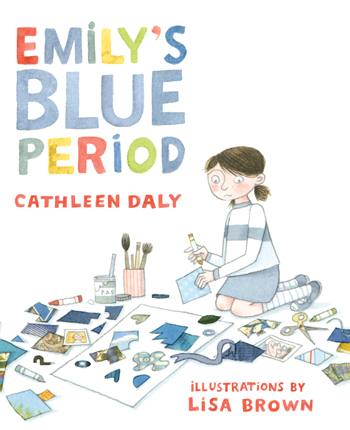Full Text Reviews: School Library Journal - 05/01/2014 Gr 1–3—A lovely, contemplative picture book. The text is short, with no more than a few sentences per page, but the writing is evocative and does a wonderful job of portraying the complicated emotions and behaviors experienced by children during confusing times. Divided into five vignettes labeled as chapters, the story is that of Emily, a young girl who loves art—particularly Pablo Picasso's unique way of portraying the world through cubism. When her parents separate, both she and her younger brother struggle to cope with the new reality. This book does a beautiful job of using the arts to show Emily's process as she grieves, accepts, and adapts to the changes in her family. The pencil and watercolor illustrations are appropriately muted, sticking to a soft blue, green, and brown color scheme with highlights of yellow and red. The subtle addition of some digital imagery creates lively, relatable illustrations. Despite the difficulties that Emily's family may be having, their imperfect life is full of love, and that comes through in both art and text. This is not a straightforward "What is divorce" story but rather a window into one girl's complicated emotional journey. It's a first purchase for libraries that have a section of picture books for older readers, and a high-quality, nondidactic book for parents and caregivers looking to start conversations about divorce.—Anna Haase Krueger, Ramsey County Library, MN - Copyright 2014 Publishers Weekly, Library Journal and/or School Library Journal used with permission. Booklist - 07/01/2014 Aspiring artist Emily is trying to make sense of her life, which right now is all in pieces, since her mom and dad don’t live together any more. In school, she learns about Picasso and his different artistic styles. For instance, in his cubism period, faces and objects aren’t where you’d expect them to be (neither is dad—he has moved out). Things are all mixed up, just the way Emily feels. So she enters her blue period, and it lasts quite a while. However, when her teacher presents collage in art class, Emily has an idea. She borrows and collects significant things, and cuts and glues them into a big, soggy, and beautiful collage, combining all she loves about her family and home into a heart-shaped picture. Artwork in the five brief chapters includes some clever examples mirroring Picasso’s styles, and each scene shows details of Emily’s character and her world. During the blue period, tones are gray and black and blue, but the final colorful collage invites children to find all the parts of Emily’s life. Artful. - Copyright 2014 Booklist. Bulletin for the Center... - 09/01/2014 Emily, a devotee of Picasso, may enjoy mixing things up in her art, but she’s not happy when it’s her family that’s mixed up and her father leaves the house to live “in his own little cube” of an apartment. Emily’s funk affects her painting, sending her into her own version of Picasso’s Blue Period. An assignment in art class (“I want you to make a collage of your house”) leads her into introspection about the nature of her home, and it’s this work that eventually allows her to make peace with the new arrangement. The clipped text has a robust and knowing energy that makes this a bracing complement to more tender stories of post-split adjustment (Stanton’s Monday, Wednesday, and Every Other Weekend, BCCB 2/14); Emily’s artistry is treated appreciatively, and her relationship with her little brother, Jack (who’s also none too pleased about the family developments) adds both humor and authenticity. The book’s format is a cross between a picture book and an early reader, with a trim size between the two, chapter breaks dividing the sparely texted episodes, and much of the dialogue appearing in speech bubbles. The art doesn’t always match the imagination of the text, but the focused, modest scenes set against copious white space add accessibility, and there’s effective pacing in the shifting layouts that move between busy assemblages of spot art and the occasional dramatic double-page spread (as when an angry Jack loses it mid-store). While this could inspire some art projects for kids who want to symbolically represent their own lives, it’s also a nicely underplayed look at family change that will speak to many youngsters’ experience. DS - Copyright 2014 The Board of Trustees of the University of Illinois. Loading...
|



